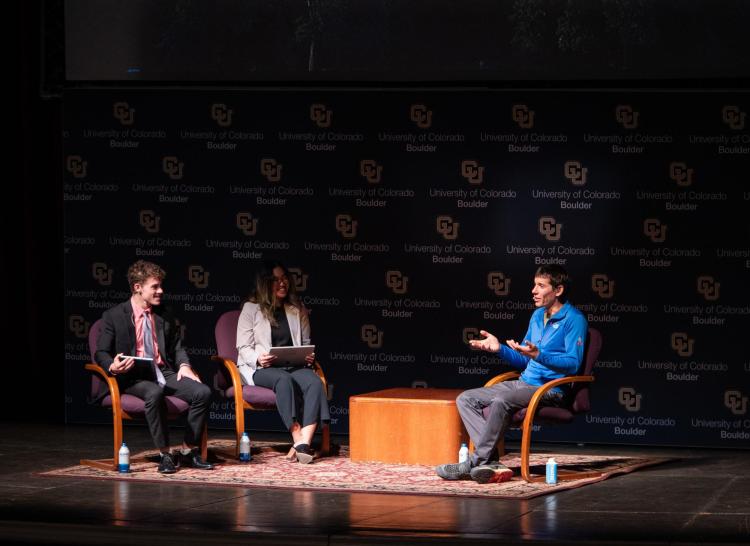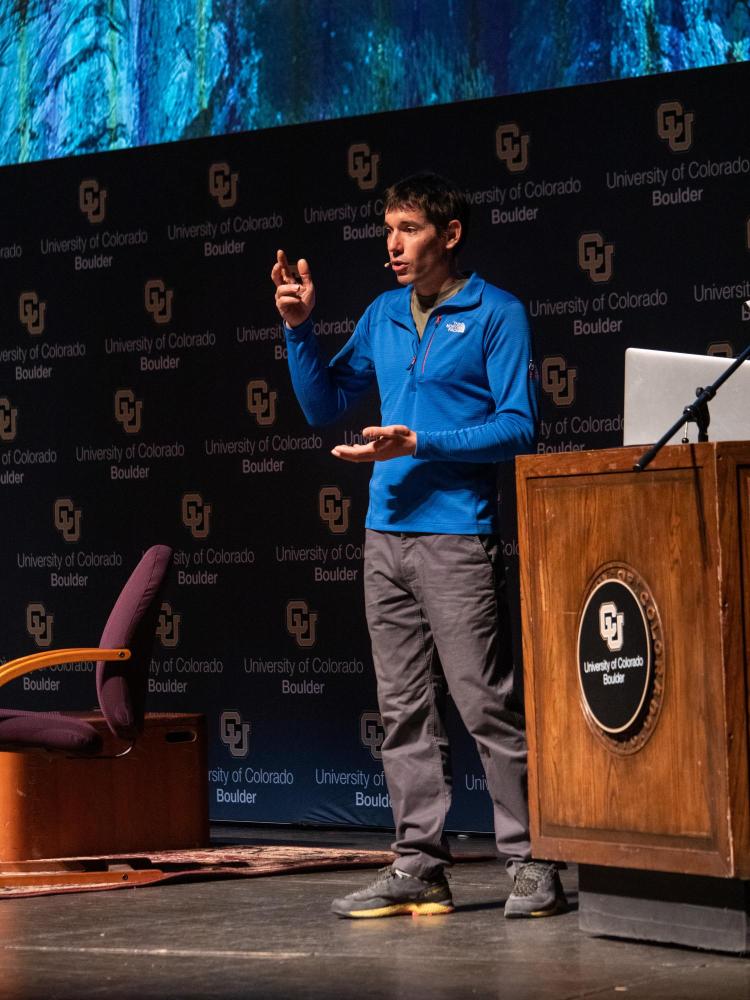Free solo climber Alex Honnold credits planning, perspective for his remarkable feats

Alex Honnold has climbed in some of the most remote regions on Earth, on all seven continents, and even on human-made buildings in major cities. In June 2017, he completed the first-ever ropeless ascent of Yosemite’s El Capitan, captured in the award-winning 2018 documentary film Free Solo.
Honnold is one of the most accomplished climbers in the realm of free soloing, the most dangerous way to climb. But his biggest fear until a couple years ago? Public speaking, Honnold admitted with a smile to a crowd of over 1,000 people Monday night at Macky Auditorium.
During the first in-person Distinguished Speakers Board event since October 2019, Honnold shared some of the many elements required to accomplish the peak moment of his professional climbing career, and how each of the challenges along the way led to his eventual success.
It’s all in the practice and planning
Attendees of the event all knew of the major feat Honnold accomplished in Free Solo, but he said very little about the actual climb. Instead, he focused on what it took to get to that moment.
The documentary follows Honnold during the two years leading up to the climb, but it actually took more than 15 years for him to train and prepare. He likened it to the difference between cramming for an exam, and deeply understanding a subject and being able teach it.
“I think it’s important to recognize the amount of effort that goes into things that are truly difficult,” said Honnold. “There’s no real shortcut for that.”
While his peak experiences of free soloing are what get the spotlight, they don’t represent how he spends most of his time. And he simply loves climbing, sport climbing five or six days a week with friends, often with people who are better than him.

Get out of your comfort zone
Honnold credits the filmmakers’ involvement in helping him achieve his goal of free soloing El Capitan: Not only did they assist with the physical effort of preparing for the climb, but they held him accountable as well.
There were moments when he felt self-conscious or embarrassed with a camera focused on his every move for two years––from a trip to the grocery store to a wait at the Department of Motor Vehicles. But he realized this discomfort could also help toughen him up to the ultimate challenge.
He recalled thinking: How am I ever going to free solo El Cap, if I can’t handle a camera on me during a 45-minute wait at the DMV?
Cut what is difficult down to size
To climb El Capitan, Honnold knew he had to first get out of Yosemite. In the years prior to his major climb, he climbed around the world in Chad, Africa, the Gulf of Oman, and in the Patagonian peaks of southern Argentina. In this part of South America, the mountains dwarf what is considered “big” in the U.S., with rock faces often two to five times the height of what Honnold had been climbing in California.
This “redefines the sense of scale,” according to Honnold, and allowed him to get perspective on his previously daunting goal back home.
It also allowed him to truly feel like “a tiny dot on a huge landscape,” one of his favorite parts of climbing. This humbling reminder of “the human’s place in the world” allowed him to return to Yosemite and not feel as overwhelmed by the granite rock face he would eventually and successfully climb.
Fear doesn’t need to be avoided
In response to an audience question about overcoming fear, Honnold commented that fear isn’t something that needs to be overcome or avoided: It’s a natural physiological response, related to the circumstances. But it doesn’t have to determine your response, he said.
“You should be determining if the fear is appropriate…Better to notice it, evaluate it and then decide, like hunger, if you need to act on it,” said Honnold.
That doesn’t mean you should do something dangerous just to do it if you don’t enjoy it. For example, Honnold never liked learning to skydive and is not interested in base jumping––an activity arguably even more dangerous than climbing without ropes.
Honnold also reiterated the importance of planning for getting through scary situations, such as climbing. When on the wall, he’s not making the decisions––he’s trying to execute the plan he made before ending up in that situation, so he can focus on the moment.
While there are many times he decides, “I’m going to continue on despite the fact it’s dangerous,” free soloing is not always as intense as it might feel. He said there are often situations when he could stop on a small ledge and call a friend if he needed to, to come and get him.
Give back for a better future
When asked about the future and the environment, Honnold emphasized the importance of people being able to have meaningful experiences outdoors, and the need for climbers to leave no trace.
In fact, Honnold founded the The Honnold Foundation in 2012 out of a desire to “help anything that helped the environment that also helps human communities.” The foundation ended up focusing on solar power, as Honnold was moved by the fact that almost 1 billion people live without access to electricity.
At the time, Honnold was living in a van and his overhead was pretty low. He was making more than he needed and thought, “I should probably use it for something.” The foundation has now completed projects all over the world, including a recent solar microgrid in Puerto Rico that he is especially proud of finishing during COVID-19.
While he did not speak about his next project about climate change and climbing in Greenland, On the Edge with Disney+, Honnold said he is concerned about climate change. He is also hopeful, as the COVID-19 pandemic initially showed “a glimpse of what humans are capable of when they’re challenged.”
The same could be said for Honnold himself.


